Hands on: Nintendo Switch review

Mixed marketing messaging and a lack of games meant the Wii U never got anywhere close to reaching its potential – let alone the lofty sales figures of its predecessor, the motion-focussed Wii.
But will you want to? Going on our first hands-on testing we can say the answer is a fairly comfortable "yes", despite higher than expected pricing – provided that Nintendo can deliver a compelling online offering.
(6 things you need to know about Nintendo Switch - straight from the live hands-on event)
Design
The Nintendo Switch is quite unlike any games console that’s ever come before it. In fine Nintendo tradition (if you can call the gaming equivalent of iconoclasm 'tradition'), it’s done away with the concept of one fixed box sat under your telly with the Switch. Instead, it exists in two distinct states: firstly as a portable tablet device with a built-in kickstand, and secondly docked in a base that connects to your TV.Paired with its breakaway, adaptable controllers it’s a bit like Nintendo’s answer to the Transformers, ready to be reconfigured depending on your current gaming need. Sat at home ready for a marathon session? Plug the tablet into the dock and beam your gameplay onto the big screen.
Sat on a train with a table in front of you and the Switch in your bag? Pop out the tablet unit’s kickstand, grab the nunchuck-like controller parts and get playing. Roaming a park? Plug the two controller sticks in either side of the screen and you can walk about and collect those Zelda rupees at the same time.
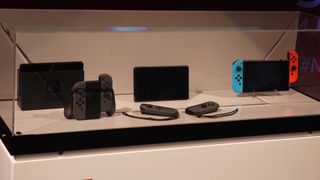
So you’re left with an unassuming dock that would sit comfortably under a serious home cinema setup, and cartridges that are portable and sturdy, and which entertainingly trade on nostalgia – if hamstringing any chances of disc-based backwards compatibility.
The key idea uniting all these elements is that, essentially, wherever you are, however much time you have, you get the same great gaming experience, taking the home console fun that you enjoy wherever it’s most convenient for you to play.
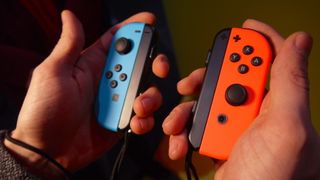
Specs and performance
But how does that experience stack up against the competition? Has Nintendo managed, for the first time in decades, to get its hardware on a level footing with the PS4 and Xbox One competition? Though you can argue that the unique form factor negates such comparisons, the simple answer is “not quite”.The Nintendo Switch is a solidly capable machine, but its internals appear far more power-efficiency focussed than geared towards pure processing grunt; certainly, at its first press event, there appear to be no games challenging the visual fidelity of Sony or Microsoft's consoles. But that's never really been the point of a Nintendo console, with the company far more concerned with innovative gameplay forms than photo-real visuals.
Under the hood of its core tablet unit you’ll find a custom Nvidia Tegra processor, broadly comparable to the Tegra X1 found in an Nvidia Shield TV. 32GB of storage space is onboard too (some of which is dedicated to the system software), along with 802.11.ac Wi-Fi.
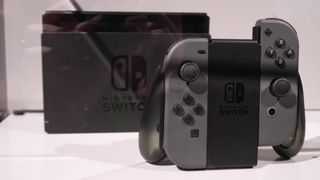
It proves itself to be a very enjoyable screen to view. It has vibrant colors, a relatively sharp resolution, and is able to keep up with the breakneck nature of Mario Kart 8 Deluxe, which we had hands-on time with. It's not as impressive as the top-end smartphone screens, but it feels dramatically better than what the Wii U Gamepad offered.
We weren't able to try out the touchscreen capabilities of the screen at the event. Whether intentionally or not, the touchscreen appeared to have been disabled on most of the demos we tried.
Supporting Wi-Fi online play, up to eight Nintendo Switch consoles can link up for local multiplayer play, and when we used this to play Mario Kart there wasn't any evidence of lag.
Battery life for on-the-go play is, of course, a concern. Nintendo quotes a very heartening six-plus hours of battery life when the Switch is disconnected from a USB-C power supply, although that's very much dependant on the title being played – Nintendo admits, for instance, that you'll get closer to three hours play when firing up The Legend of Zelda: Breath of the Wild when out and about.
We'll have to take the Switch out into the real world to see if that claimed upper number holds up.
Docked vs portable play
So, how do the two core gaming experiences (untethered on-the-go versus docked at-home play) compare? So far, very favourably.The Switch outputs to a TV at a resolution of 1080p, with 5.1 audio output offered. Considering the home console standard really remains at 1080p (with the exception of the adaptive-up-to-4K resolution of the PS4 Pro), that’s competitive. Charging from the dock, it doesn’t of course come with any battery power limitations.
Going on the few games available to play at the Nintendo press event, it seems that only the most demanding of players will notice a difference between docked and portable performance. On a 1080p television there were more jagged edges visible on the console, but frame-rate seemed un-impacted by form factor.
The docking and undocking process is as seamless as can be. We got a chance to try out Breath of the Wild in both configurations, and even switching mid-gameplay presented no trouble to the console – you just hold a couple of buttons to confirm you're using the attached Joy-Con controllers, and the game resumes exactly where you left off.
Online, interface and apps
Compared to the slick, richly web-connected interfaces of the PS4 and Xbox One, Nintendo’s most recent console interfaces have felt more than a little dated. The Switch attempts to shake this up by introducing its own online subscription service, but those looking for something comparable to PlayStation Plus or Xbox Live Gold may be left wanting.
In addition, the online service offers lobby and voice chat, but again this appears clunkily limited to a phone app. With the likes of WhatsApp and Facebook Messenger already letting you hook up with friends for free on your phone, this hardly seems a reasonable alternative to a built-in console chat option.
Nintendo subscribers will also get digital store discounts, but that doesn't seem like much of a draw of itself. The Switch will launch with a free trial to its subscription service – we'll keep you informed as to whether it's worth sticking with beyond that, when the paid service launches in Autumn 2017.
Controller
Nintendo has a habit of designing quirky controllers, from the motion-sensing Wii remotes and nunchucks to the trident-shaped N64 pad, with each bringing with it a new way to play. While the Switch’s Joy-Con controllers don't offer any remarkable new input options, they are innovative in the way they can transform depending on your current needs.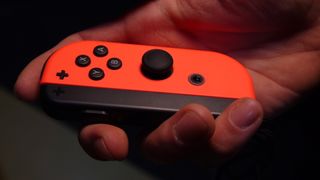
These components can be used together, separately or combined with a central Joy-Con grip unit for a more traditional play experience. The ability to use each part as a solo pad also goes some way to explaining the removal of the old-school Cross pad – with the analogue stick used as a movement input, the other buttons then potentially can be used for action commands, with the pad turned on its side like a spruced-up NES pad.
One criticism so far, based on early play, relates to the right-hand side of the Joy-Con, when it's being used in a single-controller scenario. As it's asymmetrically placed when in the Joy-Con grip, this means that all its buttons and its control stick can feel very cramped together when it's used in a solo configuration.
Each Joy-Con offers an accelerometer and gyroscope for motion controls, while the right Joy-Con also features NFC for hooking up Nintendo's amiibo figurines. Nintendo is coining what it calls 'HD Rumble' for the controllers, which it claims lets you feel vibrations as subtle as a few ice cubes shaking around in a glass.
The right controller element also features an IR Motion Camera that can detect the distance and shape of objects in particular games – Nintendo offers the example of being able to play rock/paper/scissors with the console, though it does hint at further AR or VR ambitions down the line.
When removed from the tablet, the controllers feel quite unlike any others we've played with before. They're incredibly light and very small too, which may prove fiddly for big-handed gamers. But they also prove responsive – playing the motion-based mini-games of launch title 1-2-Switch worked a treat, while the split D-Pad's buttons are low-profile enough to allow for lightning-fast Street Fighter special moves. When removed from the tablet, each Joy-Con part can have a clip-on set of shoulder buttons slid onto their sides, too.
Again, the flexibility of the controller options makes for a very dynamic system. In theory, for example, you can get four players around one Switch console with two complete Joy-Con controllers, if each player uses an individual left or right side pad. The combinations seem confusing on paper, but in practice should be quite intuitive. Less clear at this point is how many controller in total the Switch supports, once you start including the more traditional Nintendo Switch Pro pads into the mix.
Though it was hard to get a proper sense of the weight of the tablet and Joy-Con controllers combined, due to the security housing Nintendo had wrapped them in, even with the additional safety measures everything felt very light, and certainly portable-friendly. However, it's worth noting that the controllers are charged via the Switch itself, so make sure you've juiced both as fully as possible in the dock before heading on out; there's no way to charge them separately.
Games: the launch lineup and beyond
But what’s a games console without the games? The Nintendo Switch has a number of both first- and third-party titles ready to go in the console's first year, including big franchise hitters like Mario and Zelda, although the day one launch lineup is looking a little spartan.The Legend of Zelda: Breath of the Wild appears the most compelling so far, set for release on March 3 alongside the Switch itself. It'll be joined by 1-2-Switch, a title that makes full use of the controllers and little screen interaction to ensure players are looking into each other's eyes, with mini-games including wildwest gunslinging.
ARMS, a multiplayer futuristic boxing game, uses the Joy-Con pads to throw punches, and will be ready "this spring".
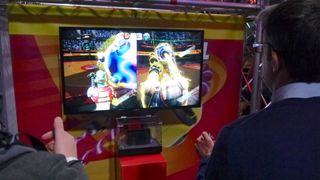
Mario Kart 8 Deluxe makes the superb racer portable, and introduces new courses, items and racers – it'll be ready on April 28.

Paintball multiplayer shooter Splatoon 2 will be ready for the summer, while the surprisingly engrossing Snipperclips – Cut It Out Together! will launch in March; it's puzzle game that enables you to cut shapes out and bring them into the game to help solve challenges.

In one example, we cut our fellow player's character into a shovel shape, so that she could scoop a basketball into a net. It's very charming, and seemed perfect for playing sat next to another gamer in tablet mode, away from the big screen.
Xenoblade Chronicles 2, meanwhile, with its space-faring mechs, will keep RPG fans happy.
So where's Mario? He'll miss the launch, with Super Mario Odyssey arriving in time for Christmas. It sounds like it'll be worth the wait, though, with Odyssey being the first 'sandbox' Mario game since Super Mario Sunshine on the GameCube, letting you explore wide-open worlds.
A number of third-party titles have also been teased, including EA's FIFA, The Elder Scrolls V: Skyrim, NBA 2K, Project Octopath Traveler, Street Fighter II Ultra, Sonic Mania, Super Bomberman, Just Dance, Disegea 5, Dragon Quest's X and XI, Fire Emblem Warriors, and Minecraft.
The issue, as was the case with the N64 and Wii U, will be retaining third-party support. The Switch’s unique hardware, like that of the Wii U, forces additional design considerations upon developers, which can become costly in gruelling development cycles. The Switch seems far more accommodating in this respect than the Wii U ever was, but it’ll be interesting to see if the chicken-and-egg scenario between playerbase and game catalogue can find a happy balance this time around.
Early verdict
The Switch is a confident showing from Nintendo at this early hands-on stage. Rather than falling on its sword and following the straightforward 'box-under-your-telly' design ethos, Nintendo has taken bold strides to once again mix up the gaming experience. Hopefully, third-party developers will make the jump into the unknown with it.Flexible and fun, without feeling like a toy, the Switch is proving that Nintendo’s ideas can remain joyously novel without alienating the more po-faced of gamers. While on-the-go battery life and performance remain a concern until we can try out extensive real-world play on the Switch, Nintendo’s new machine is looking very promising; it just needs the games to make use of this innovative hardware.
With a price point set at £279.99 / $299.99 / AU$469.95, the Switch is going to have a mighty fight ahead of it against the relatively affordable PS4 and Xbox One bundles – and that's before we learn more about the Xbox Scorpio, which we'd expect to be far more powerful, but far pricier.
Still, there's nothing like pulling off a Super Mario triple jump, eh?










No comments: